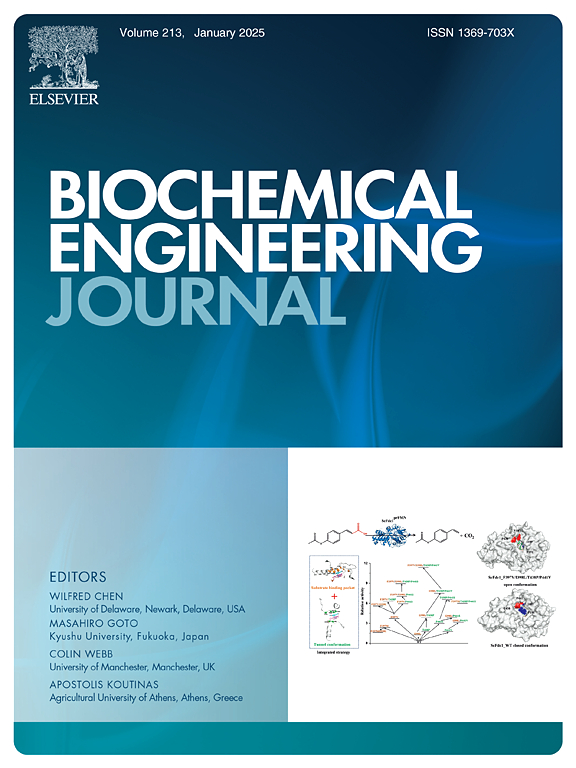Simultaneous enzymatic hydrolysis and bioconversion of deacetylated and disk refined sugarcane bagasse to single-cell protein: An experimental investigation and techno-economic analysis
IF 3.7
3区 生物学
Q2 BIOTECHNOLOGY & APPLIED MICROBIOLOGY
引用次数: 0
Abstract
Rising animal feed costs are driving up animal agriculture and food prices. While single-cell protein (SCP) production from lignocellulosic waste offers a solution, pretreatment of these feedstocks is required. In this study, the SCP yield from sugarcane bagasse pretreated via deacetylation in combination with disk refining (DDR), prior to simultaneous enzymatic hydrolysis and fermentation using P. ostreatus and F. venenatum compared to S. cerevisiae, was investigated. A biorefinery was simulated to investigate the economic feasibility of animal feed enhanced with SCP, using a discounted cashflow analysis. Deacetylation and DDR were effective pretreatment approaches, improving enzymatic digestibility from 9.10 g sugar/100 g dry matter (DM) to 75.75 and 80.14 g sugar/100 g DM, respectively, which was comparable to steam-explosion pretreatment. Pretreated bagasse was successfully converted to SCP through simultaneous enzymatic hydrolysis and bioconversion. However, DDR was preferred for bioconversions using P. ostreatus and F. venenatum, achieving SCP yields of 4.24 ± 0.17 and 3.47 ± 0.33 g protein/100 g DM, respectively. In the ranges investigated, solids loading had a more pronounced effect on the SCP yield than enzyme dosage, irrespective of the microorganism used. However, the minimum selling price of animal feed enhanced with SCP (0.69 US$/kg) remains higher than the market price of animal feeds like soybean meal (0.40 US$/kg). The technology shows promise but can be further optimised.
脱乙酰和圆盘精制甘蔗渣同时酶解和生物转化为单细胞蛋白:实验研究和技术经济分析
不断上涨的动物饲料成本推高了动物农业和食品价格。虽然从木质纤维素废料中生产单细胞蛋白(SCP)提供了一种解决方案,但需要对这些原料进行预处理。在这项研究中,研究了在P. ostreatus和F. venenatum同时酶解和发酵之前,通过脱乙酰和圆盘精炼(DDR)预处理蔗渣的SCP产量,并与S. cerevisiae进行了比较。利用贴现现金流分析,模拟了一个生物精炼厂,以研究用SCP增强动物饲料的经济可行性。脱乙酰和DDR是有效的预处理方法,酶消化率分别从9.10 g糖/100 g干物质(DM)提高到75.75和80.14 g糖/100 g DM,与蒸汽爆炸预处理相当。通过酶解和生物转化,成功地将预处理甘蔗渣转化为SCP。然而,DDR更适合于利用P. ostreatus和F. venenatum进行生物转化,SCP产量分别为4.24 ± 0.17和3.47 ± 0.33 g protein/100 g DM。在所调查的范围内,无论使用何种微生物,固体负荷对SCP产率的影响比酶用量更明显。然而,添加SCP的动物饲料的最低销售价格(0.69美元/公斤)仍然高于豆粕等动物饲料的市场价格(0.40美元/公斤)。这项技术很有前景,但还需要进一步优化。
本文章由计算机程序翻译,如有差异,请以英文原文为准。
求助全文
约1分钟内获得全文
求助全文
来源期刊

Biochemical Engineering Journal
工程技术-工程:化工
CiteScore
7.10
自引率
5.10%
发文量
380
审稿时长
34 days
期刊介绍:
The Biochemical Engineering Journal aims to promote progress in the crucial chemical engineering aspects of the development of biological processes associated with everything from raw materials preparation to product recovery relevant to industries as diverse as medical/healthcare, industrial biotechnology, and environmental biotechnology.
The Journal welcomes full length original research papers, short communications, and review papers* in the following research fields:
Biocatalysis (enzyme or microbial) and biotransformations, including immobilized biocatalyst preparation and kinetics
Biosensors and Biodevices including biofabrication and novel fuel cell development
Bioseparations including scale-up and protein refolding/renaturation
Environmental Bioengineering including bioconversion, bioremediation, and microbial fuel cells
Bioreactor Systems including characterization, optimization and scale-up
Bioresources and Biorefinery Engineering including biomass conversion, biofuels, bioenergy, and optimization
Industrial Biotechnology including specialty chemicals, platform chemicals and neutraceuticals
Biomaterials and Tissue Engineering including bioartificial organs, cell encapsulation, and controlled release
Cell Culture Engineering (plant, animal or insect cells) including viral vectors, monoclonal antibodies, recombinant proteins, vaccines, and secondary metabolites
Cell Therapies and Stem Cells including pluripotent, mesenchymal and hematopoietic stem cells; immunotherapies; tissue-specific differentiation; and cryopreservation
Metabolic Engineering, Systems and Synthetic Biology including OMICS, bioinformatics, in silico biology, and metabolic flux analysis
Protein Engineering including enzyme engineering and directed evolution.
 求助内容:
求助内容: 应助结果提醒方式:
应助结果提醒方式:


